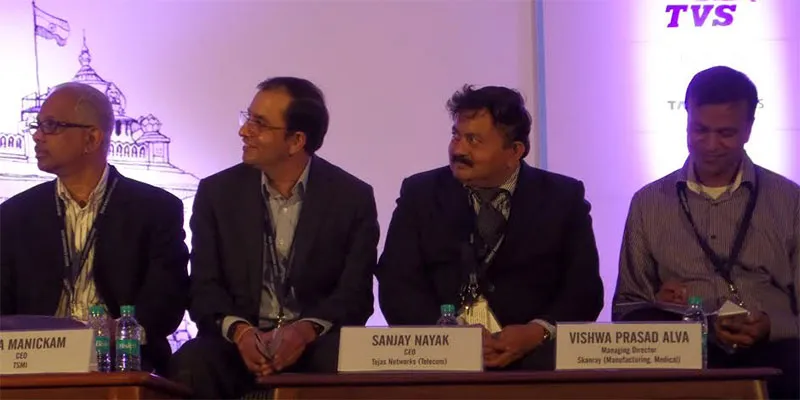Why electronics manufacturing is making a comeback in Karnataka
India’s early forays into electronics manufacturing were overshadowed by the IT and BPO wave – but the return to manufacturing is a growing trend, according to a range of industry and government experts at the Invest Karnataka 2016 summit.
State strengths and policy
“Many startups in Karnataka today are looking at manufacturing activities – and not just from Bengaluru but Mysore and Belgaum as well,” said V. Manjula, Principal Secretary, Dept of IT, BT and S&T, Karnataka. “Globalisation is great, but Indian companies should not overlook local markets either,” she urged.
Karnataka has a lot of engineering talent, thanks to its 200 engineering colleges and 300 industrial training centres. The state’s Electronics System Design and Manufacturing (ESDM) policy now includes venture capital support as well, through the Karnataka Semiconductor Venture Fund (KarSemVen), which has supported six startups already to the tune of Rs 30 crore.

Karnataka’s policy vision is to see 20,000 tech startups in the state by 2020, with 6,000 product startups in the mix. “This will lead to 600,000 direct jobs and 1.2 million indirect jobs,” claimed V. Manjula. The policy also includes partnership options to set up incubators along with the private sector.
Make in India
“Karnataka has a vibrant ecosystem for design-led manufacturing,” said Sanjay Nayak, CEO, Tejas Networks. “Earlier models of ‘design elsewhere, Make in India’ or ‘design in India, make elsewhere,’ should be replaced by ‘design and Make in India,’” he urged. He pointed to Apple as a great example of outstanding design and global manufacture; it is able to extract $321 in value for itself from every $500 of product sale.
“Indian customers today want the latest technology with the highest quality but lowest price, making it the gold standard in competitiveness,” said Sanjay. Fortunately, Bengaluru can meet the challenge, thanks to its talented workforce and its exposure to global best practices. The R&D leverage here is a factor of four as compared to Western resources.
As a result, Tejas is now among the top 10 global players in optical networks. Sanjay claimed that the majority of India’s phone calls and Internet traffic runs over some Tejas equipment.
Taiwanese company MediaTek has also set up an R&D centre in Bengaluru. The lifecycle of telecom products is shrinking, particularly in mobile, and India is seen as a giant mobile market – thus making Bengaluru an important place to understand, immerse, and innovate.
The Indian mindset
A handful of Indian electronics manufacturers have certainly succeeded in India, but the overseas market has played a key role in their success as well. “Many Indian customers will buy Indian high-tech products only if they are successful first in the US, Germany, and Japan,” observed Vishwa Prasad Alva, MD, Skanray. The medical electronics company has manufacturing centres in Europe and Brazil as well, with Mexico and Russia planned next.
Indian manufacturing coupled with scale can replicate the China effect, which led to the reduction of mobile phone costs from about $1,000 in its early years to the $100 smartphone today. “Costs of medical electronic equipment such as X-ray machines, ECGs, and scanners can come down by 20–60 per cent without any loss of quality,” claimed Vishwa Prasad.
Partnering with MNCs, exporting to the West, and getting international credentials are necessary for local manufacturers to succeed in India.
GE Healthcare: The local global
“Bengaluru has been a major hub for engineering and design talent for hundreds of MNCs,” said Shyam Rajan, Chief Technology Officer, GE Healthcare India. The company employs 1,550 engineers in its centre in Bengaluru, and over 100 products have been designed already. GE also has joint ventures with Wipro and BEL.
India is facing major health challenges, with the rise of non-communicable diseases as well as high casualty rates among infants. Shyam cited data which showed that out of 139 million babies born each year in India, one million die the day they are born, and four million die in the first month.
This has spurred GE India to come up with affordable devices like the rural infant warmer, which can be moved around on wheels and can keep babies warm in the critical early months. GE India has also produced over 100 bio-imaging scanners using frugal innovation methods as a foundation, based on ruggedisation, modularisation, user-friendly design, and affordability.
“Frugality blends ‘the magic of science with empathy,” said Shyam. The company has set new benchmarks by embracing principles of design thinking and stretching beyond traditional B2B boundaries into B2C customer experience.
“The ultimate goal is to design devices as easy to use as a TV remote – with just three buttons that are unbreakable,” explained Shyam (see my coverage of user experience design insights from the Design Summit 2015 and UX India 2015).
Creative confidence
“Creative confidence for entrepreneurs to enter the electronics manufacturing sector in India is increasing,” said P. Raja Manickam, Founder and CEO of Bangalore-headquartered semiconductor testing company Tessolve.
“Students in India need to know that manufacturing in India is an attractive sector,” said P. Raja. Ironically, MNCs seem to have more faith in India’s electronics R&D and manufacturing than Indian customers and entrepreneurs, but hopefully the tipping point has been reached. “There is more optimism outside and scepticism inside,” observed P. Raja.
“There is less of a ‘me too’ copy-cat attitude now, and the desire in youth and professionals to innovate for India is strong,” he added. “This is the right time for Make in India,” agreed Vishwa Prasad of Skanray.







